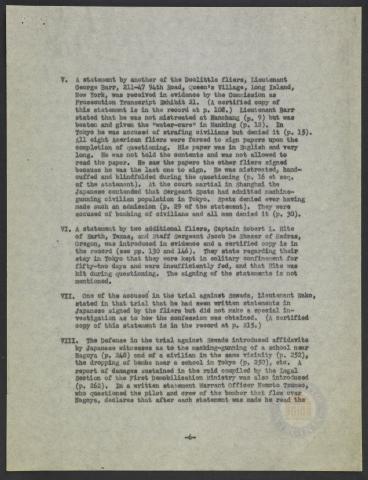
Page 6
| Parent | Circumstances surrounding the "confessions" of the Doolittle flyers |
|---|---|
| Date | 16 September 1947 |
| Language | English |
| Collection | Tavenner Papers & IMTFE Official Records |
| Box | Box 5 |
| Folder | General Memoranda and Reports from September 1947 |
| Repository | University of Virginia Law Library |
V. A statement by another of the Doolittle fliers, Lieutenant George Barr, 211-47 94th Road, Queen?ÇÖs Village, Long Island, New York, was received in evidence by the Commission as Prosecution Transcript Exhibit 21. (A certified copy of this statement is in the record at p. 108). Lieutenant Barr stated that he was not mistreated at Nanchang (p. 9) but was beaten and given the ?Ç£water-cure?Ç¥ in Nanking (p. 12). In Tokyo he was accused of strafing civilians but denied it (p. 15). All eight American fliers were forced to sign papers upon the completion of questioning. His paper was in English and very long. He was not told the contents and was not allowed to read the paper. He saw the paper the other fliers signed because he was the last one to sign. He was mistreated, handcuffed and blindfolded during the questioning (p. 16 et seq. of the statement). At the court martial in Shanghai the Japanese contended that Sergeant Spatz had admitted machine-gunning civilian population in Tokyo. Spatz denied every having made such an admission (p. 29 of the statement). They were accused of bombing of civilians and all men denied it (p. 30. VI. A statement by two additional fliers, Captain Robert L. Hite of Earth, Texas, and Staff Sergeant Jacob De Shazer of Madras, Oregon, was introduced in evidence and a certified copy in the record (see pp. 130 and 146). They state regarding their stay in Tokyo that they were kept in solitary confinement for fifty-two days and were insufficiently feed, and that Hite was hit during questioning. The signing of the statements is not mentioned. VII. One of the accused in the trial against Sawada, Lieutenant Wako, stated in that trial that he had seen written statements in Japanese signed by the fliers but did not make a special investigation as to how the confession was obtained. (A certified copy of this statement is in the record at p. 215.) VIII. The Defense in the trial against Sawada introduced affidavits by Japanese witnesses as to the machine-gunning of a school near Nagoya (p. 248) and of a civilian in the same vicinity (p. 252), the dropping of bombs near a school in Tokyo (p. 25)), etc. A report of damages sustained in the raid compiled by the Legal Section of the First Demobilization Ministry was also introduced (p. 262). In a written statement Warrant Officer Nemoto Tsumeo, who questioned the pilot and crew of the bomber that flew over Nagoya, declares that after each statement was made he read the -6-
